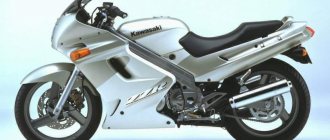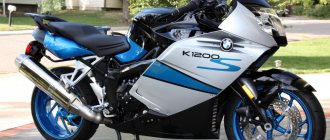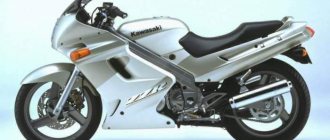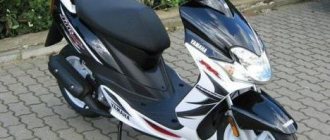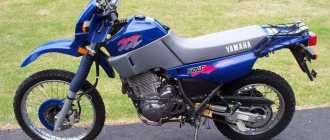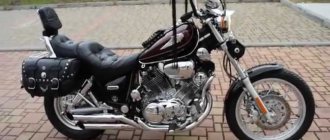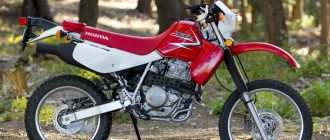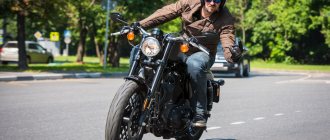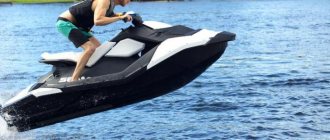This motorcycle is perfect for different people, because in its class it is a naked bike. The model is easy to control, has little weight and is generally very beginner-friendly. Although, of course, if a person has never ridden motorcycles before, it is better for him to look for something 125 cc, but not 600 cc, like this bike.
Yamaha XZ6 Divershen is a good mid-ranger for its class, which can become an excellent companion for commuting to work or for a pleasant time somewhere outside the city. But it is important to remember that it has nothing to do with SUVs.
Model description
The Yamaha XJ6 motorcycle belongs to the middle class of equipment with engines up to 600 cubic centimeters. It joined the model line of the famous manufacturer in 2009.
The XJ6 model belongs to the naked class, designed for city streets, but it is good because it is universal and feels equally at home on highways and on country roads.
The new diamond frame design, made from high-strength steel tubing, precisely balances lateral stiffness for smooth cornering.
The four-row powertrain's tuning ensures low- to mid-range responsiveness that's ideal for spirited riding.
The chassis is compact, narrow, comfortable and lightweight with a low seat height and a modern design. Yamaha XJ6 motorcycles are suitable for both novice pilots and experienced drivers.
The tubular frame has reduced the dimensions of the motorcycle and its weight, which allows it to reliably follow a given trajectory. Even short riders can put their feet on the road when maneuvering at low speeds.
The instrument panel consists of an analogue tachometer and a multifunction display with a speedometer. The instruments are easy to read even at night, because, firstly, the tachometer needle is made with a luminescent coating, and secondly, the panel is illuminated with white LED backlighting.
It was produced in three colors - yellow (Extreme Yellow), black (Midnight Black) and white (Cloudy White).
Advantages of a motorcycle
The compact Yamaha XJ6 motorcycle is simple and easy to ride. It perfectly combines handling and high performance.
The motorcycle is equipped with an engine with high torque already at low and medium shaft speeds.
The designers, by installing an adjustable steering wheel and a low saddle, allowed an adult driver of any height to choose an ergonomic, comfortable fit. True, reviews from motorcyclists closer to 190 cm tall and weighing 90 kg dampen such optimism. No settings or adjustments help them feel comfortable behind the wheel.
And not the least role in describing the advantages of the motorcycle is played by its stylish and beautiful appearance, which, combined with its low weight, makes the XJ6 attractive to the fair half of humanity.
History of changes
Despite the long production period, the XJ6 Diversion has not undergone significant changes. However, something happened in his biography, and a sports version was released, in the name of which the letter “F” appeared at the end.
To summarize, we should note the main advantages of the XJ6 Diversion, including:
- reliability and simplicity;
- maneuverability and lightness;
- comfortable fit;
- durable engine;
- good wind protection, which, by the way, can be strengthened.
The XJ6 Diversion can compete with many mid-range naked bikes that have a much later release date. An excellent choice for experienced and not so experienced bikers who can handle a 600cc motorcycle.
Disadvantages of a motorcycle
Owner reviews about the Yamaha XJ6 are not enthusiastic, but mostly positive.
Yes, a large man (the Japanese don’t grow up like that) is not only uncomfortable behind the wheel, he also needs to manage to look in the rear-view mirrors.
Very mixed reviews about long trips. Some are completely delighted, while others think that the seat is too thin and hard to sit on for a long journey, especially with the shocks transmitted from the rear budget suspension.
Pre-restyling models had very uncomfortable handles for the passenger.
Maybe the Japanese responded to calls to make life easier for the second number and therefore improved the passenger handles.
The low bike, according to pilots, scrapes the footrest on the asphalt with every turn, and the brackets on which it is attached are weak and bend, replenishing the blood of an inexperienced passenger with adrenaline.
The low beam, which dimly illuminates the periphery, also caused some dissatisfaction.
And, probably, the desire to see the gear number on the dashboard seems like an unreasonable whim in a budget model.
Otherwise, the XJ6 is fully consistent with its price: it is simple and reliable.
Power point
For the lightweight Yamaha XJ6 motorcycle, the characteristics of the upgraded engine are perfectly suited.
The displacement of the four-stroke in-line four-cylinder liquid-cooled engine is 600 cc. The unit develops a maximum power of 78 hp. (57 kW) at 10 thousand rpm, and the maximum torque is 59.7 Nm at 8.5 thousand rpm.
The cylinders are inclined forward, each of them has four valves, camshafts, and there are two of them, overhead. The newly designed cylinder head allows for a higher compression ratio. Intake ports have been reduced. To increase rigidity, the upper half of the crankcase is made as a single unit with the cylinder block.
The camshaft cam profile is designed to provide high torque at low and medium crankshaft speeds.
To reduce the weight of the motorcycle, the pistons are forged aluminum.
The fuel injection system has dual-directional four-port fuel injectors.
The muffler of the exhaust system, the configuration of which is “4-1”, is located under the frame. It is equipped with an oxygen sensor and a three-way catalytic converter.
And this is not all the features of the engine system of the Yamaha XJ6 motorcycle.
Measurement results
| KAWASAKI ER-6F (2010) | YAMAHA XJ6 DIVERSION (2010) | |
| MAX. SHAFT POWER | 63.2 HP AT 8750 RPM | 65.7 HP AT 9250 RPM |
| MAX. POWER AT THE WHEEL | 69.3 HP AT 8750 RPM | 72.1 HP AT 9250 RPM |
| MAX. TORQUE ON SHAFT | 60 NM AT 7250 RPM | 53.3 NM AT 8250 RPM |
| MAX. TORQUE ON WHEEL | 64.5 NM AT 7250 RPM | 58.4 NM AT 8250 RPM |
| SPECIFIC SHAFT POWER | 106.7 HP/LITER | 120.2 HP/LITER |
| ACCELERATION | ||
| 0-100 M | 119.2 KM/H IN 5.165 S | 117.5 KM/H IN 5.253 S |
| 0-200 M | 148 KM/H IN 7.848 S | 144.9 KM/H IN 7.964 S |
| 0-300 M | 164.4 KM/H IN 10.144 S | 161.3 KM/H IN 10.293 S |
| 0-400 M | 176.6 KM/H IN 12.253 S | 172.7 KM/H IN 12.452 S |
| PERFORMANCE CHARACTERISTICS | ||
| MAX. SPEED | 207.1 km/h | 201.8 km/h |
| WEIGHT WITHOUT FUEL | 196.6 KG (98.4 FRONT; 98.2 REAR) | 202.2 KG (101.4 FRONT; 100.8 REAR) |
| FUEL CONSUMPTION IN THE CITY | 6.1 L/100 KM | 6.3 L/100 KM |
| IN THE COUNTRY | 5.7 L/100 KM | 5.9 L/100 KM |
| AT SPEED 130 KM/H | 5.9 L/100 KM | 6.2 L/100 KM |
“The ER-6f engine reaches peak power at 8500 rpm, however, from 7500 rpm the dynamics of horsepower growth drops. At higher operating modes, the Diversion engine is ahead of its competitor in power, but not in torque."
Taken from BIKE magazine No. 4/2010
Motorcycle Specifications
The Yamaha XJ6 motorcycle with dimensions (LWD) 2.1 x 0.7 x 1.1, seat height 0.8 m, wheelbase 1.44 m, ground clearance 0.14 m, equipped with ABS, weighs 210 kg, and without it even more less – 205 kg.
It develops a maximum speed of about 215 km/h, and accelerates to 100 km/h in 3.9 seconds. The fuel tank capacity is a little more than 17 liters.
As for fuel consumption, the manufacturer claims an average of 5.8 liters per 100 km.
Transmission and chassis
The engine is paired with a six-speed gearbox with constant mesh gears. The wheel drive is chain driven, with a lightweight 520 chain, which has a low braking effect.
The front suspension of the Yamaha XJ6 motorcycle uses a conventional telescopic fork, its travel is 13 cm.
The rear suspension is a Monocross pendulum narrow arm - made of a profile pipe with the same stroke as the front one.
The angle of inclination of the wheel rotation axis is 26°, and its offset is 10.4 cm.
The clutch is multi-disc oil, the starting system is starter, electric.
The braking system includes a 298mm dual disc front and a 245mm single disc brake with lightweight 4.5mm thick discs.
Light-alloy cast five-spoke wheels with a diameter of 17 inches are installed in sizes 120/70 on the front and 160/60 mm on the rear wheels of the Yamaha XJ6 motorcycle.
Quiet
These include the Kawasaki ER-6f and Yamaha XJ6 Diversion . Just turn on the ignition and the rest will come naturally. Pleasant and intuitive controls are suitable for any beginner: make and receive calls, write SMS and don’t worry about the battery running out. At the same time, the presence of fairings makes the motorcycles also suitable for riding for hundreds of kilometers.
We start the motorcycle engines... and in response we hear (almost) silence. If there were a competition for the quietest exhaust sound - static and in motion - the ER-6f and Diversion would definitely win prizes. True, the sound of the Kawasaki engine is a little more lively and sporty, which is quite consistent with the image of the “brother of the younger Ninja.” Externally, the ER-6f closely inherits the image of this sportbike. The diversion is more restrained in appearance, and the color scheme of the motorcycle is calmer. Returning to the exhaust sound, or more precisely, the shape of the exhaust systems, we note that both motorcycles have muffler banks located at the bottom. This makes life easier for the passenger and eliminates problems with installing side cases of a certain shape. By the way, the most common tank bags with magnetic fastenings are also suitable for these motorcycles: their tanks are made of metal.
"1. Excellent instrumentation, but the tachometer and fuel level indicators, which are actually combined into one line, are difficult to read 2. Both the brake lever and the clutch lever can be adjusted 3. The front turn signals of the ER-6f are integrated into the fairing. They look quite elegant 4. The hole of the low-mounted muffler can is located on the right side 5. The rear suspension shock absorber is installed on the side, there is no lever. The rider and passenger footpegs are equipped with rubber pads 6. Rear 220mm petal disc brake with 2-piston caliper. The front discs are also petal"
As mentioned above, the Kava is more sporty in appearance: it’s not for nothing that in the States the motorcycle is sold as the Ninja 650. The riding position on the ER-6f also has a more sporty slant: the tank is located close to the rider, the saddle is 5 mm higher than that of the Diversion, yes and in terms of density it is much stiffer. The weight is slightly shifted forward - enough to get the thrill of active cornering, but at the same time not deprive the bike of comfort when riding long distances. The ER-6f, like the Diversion, will not be a burden for a rider with a height of 170 cm, although the weight of the motorcycles, as for a 600-k, is not small: 196.6 kg for Kawasaki and 202.2 kg for Yamaha (without fuel, according to data measurements). Unlike the ER-6f, the Diversion offers the most relaxed ride possible. An extremely comfortable seating position, even despite a larger tank (17.3 liters versus 15.5 liters for the Kawasaki) between the rider’s legs, a wide and high handlebar, and slightly forward footpegs - all this creates ideal conditions for a quiet ride. For sportier driving on the Diversion, Yamaha developers should change the weight distribution with an emphasis on the front wheel. The vocation of a motorcycle-traveler is emphasized by excellent wind protection - more developed than that of the ER-6f, and a calm 4-cylinder in-line engine, which throughout the entire range transmits very little vibration to the handlebars and footpegs and... even less emotions to the rider.
Overview of modifications
The XJ6 Diversion model became a kind of continuation of the more powerful Yamaha FZ6 and replaced it in the European markets. In America it is sold under the name FZ6R.
It was produced almost from the very beginning in three versions: a basic one with a front fairing, without a front fairing with the index N in the model designation, and in a sports version, designated by the letter F.
The model in all variants was restyled in 2013.
The side panels have been redesigned, and changes have been made to the headlight fairing, passenger handles and LED instrument panel lighting. Yellow color has been removed from the color options; the basic version can be equipped with an ABS anti-lock braking system as an additional option. The saddle received a new leather trim, and the turn signals received new lenses. The chain tension system position indicator appears.
At the same time, Yamaha released a limited edition XJ 6 SP Dark Menace. It differs only in the spectacular carbon fiber finish, combined and six on the fairings.
Test drives and reviews of the motorcycle
Experienced pilots confirm that the operating speed range is quite wide; in city traffic, you can not change gears frequently and still accelerate intensively.
The engine starts with a typical muffled, low sound. Motorcyclists consider this an element of passive safety, because the XJ6 will not go unnoticed by surrounding motorists. It starts easily, starting almost at idle speed.
Pilots also like the effective braking system, especially with the ABS system, and the balanced suspension. The motorcycle easily takes the sharpest turns and overcomes road unevenness.
Reviews about the Yamaha XJ6 (almost all, at least from those motorcyclists who have something to compare with) agree that this is a city motorcycle. It is maneuverable, easy to control, even the wider rear tire helps with this, but it is not comfortable enough for travel.
Experienced bikers lack character in this motorcycle, but for beginners this behavior of the machine is a great advantage.
Yamaha XJ6 is an honest motorcycle. What it costs is what it provides: simplicity and cost-effectiveness of maintenance, unpretentiousness, responsiveness, versatility, truly Japanese reliability and the absence of design flaws. As a bonus, there is a stylish and modern design that looks more expensive than it actually is. And even though it may seem overly predictable and calm to spoiled pilots, beginners feel more confident on it, and this is worth a lot.
What made me decide to write a review was the paucity of information about this motorcycle. If you look for something about it, you will immediately find several reviews about converting it into a cafe racer. There is much less information about the stock motorcycle, at least in Russian. Nevertheless, the diversion was a bestseller in Europe, and many good copies can still be brought from there. Next, I will talk about my impressions of riding this motorcycle, and also describe the investments in its content (many letters!). In short, this is an excellent motorcycle for both beginners and routine daily use. It has practically no character, but it is reliable and comfortable, like house slippers.
If you are a beginner and are choosing a motorcycle, you will hear voices everywhere advising you to buy a cibi (Honda CB400). When you go out into the street, a person will meet you at the bus stop, and just by looking at you, he will clearly inquire: “What, you don’t have anything to ride? Take the Sibishka, she’ll go anywhere!” On the bus, the conductor will tell you: “Why does a beginner need more than 400 cc, the bus has enough dynamics, and it also has VTEC!” Even a grandmother selling cucumbers at the market will answer your question “how much”: “Sibishka is what you need!” I also started my choice of a motorcycle with such advice. However, after reading a certain amount of your internet, I realized that a fairing is needed, wind protection is needed on the track, and it also helps from rain. Scabies are mostly naked. Well, secondly, the enthusiasm to take a 400 cc Japanese one gave way to the search for the most practical motorcycle after talking with experienced motorcyclists and watching these two videos: Issue 11. Typical defects of an in-line Japanese 400.
Typical defects of the Japanese inline 400. part 2.
The defects are really typical - we finish most 400 cc motorcycles after Japan. In Japan, it is summer all year round, they earn enough money for gasoline and can travel a lot. Owners of 400cc motorcycles, don't get me wrong. I will readily believe that your motorcycle is well-maintained and technically remarkable, I’m talking about the market for the most part. And the motorcycle market in Samara is generally rotten, most of the supply is from China, Izhik, junk, cast-offs. If you raise the bar to 500-600 cubic meters, then the market for motorcycles that can be purchased for a little more than 100 thousand rubles (and I was looking specifically in the price range of 100,000 - 140,000 rubles, but better for 90,000 rubles, is relevant for 2014. ) not in the designer's condition, narrows to the point of indecency: Yamaha XJ600, Kawasaki GPZ 500, Honda CB500 two-cylinder European model, with interference fit - Kawasaki ZR7 (rare). In general, this is how I came to the Yamaha XJ600S Diversion 1999, from Germany.
I bought it based on a picture on the Internet, without knowing anything at all about the specific copy being purchased, except for the words of the distiller, “I won’t bring bullshit.” I didn't make a mistake. Condition: 4+. The motorcycle was pressed on both sides, but not too much; apparently there were no slips. One muffler is slightly rubbed, it is clear that the corners of the plastic on the muzzle have been touched and painted over. The paint is original everywhere, this can be seen on the tank from the Yamaha branded stickers patched at the factory. The leather on the seat is also original - after reupholstery, such high-quality embossing with stitches does not happen. The mileage was shown at 41,000. I bought it at the beginning of 2014, that is, it was 15 years old. Metzeler Lazertec tires - the front is almost completely worn out, the rear tread remains 1.5-2 mm in the center. There was no significant wear on the sides - the motorcycle was not zealously pawned. Both rubber cylinders are approximately the same age, 5-6 years old, judging by the wear - they slowed down more than they accelerated. That is, moderate exploitation, very much so. The engine had sealant and was disassembled. Compression on a warm engine is 12.7...12.9 in all pots, the timing chain tensioner is in the middle of extension and works without jamming - we can say the timing chain is not far from new. I assume that most likely there was a replacement of at least the chain and piston rings, and the mileage could be either 140 or indefinitely twisted - these engines have a very decent resource. Although the services objected - the mileage is most likely honest. However, if it has been driven a lot, it is closer to new condition - judging by the tires, it has not been driven much in the last 5-6 years. Air-cooled engine, two camshafts, 8 valves. Well, now my feelings about everything in order.
Engine, dynamics
This motorcycle has a 600 cc engine, heavily derated for the sake of durability. Power is only 61 horses per approximately 200 kg of weight.
What can I say, in general, in the city you will feel faster than most cars, or rather almost all cars with an engine of less than 2.5 liters without a turbine. I measured the acceleration to hundreds twice, it was 5.5 seconds to hundreds on a flat road and 6 seconds up an easy hill (the rated value is 4.7 seconds). But I did not turn it up a little, as I later found out when analyzing the frequency response of the audio recording - the acceleration was measured with a voice recorder. Of course, it would be possible to accelerate a little faster, but there would not be a dramatic difference. With a passenger, the motorcycle accelerates to hundreds in 8 seconds. If we compare the dynamics up to a hundred, then alone it turns out to be on par with the Infinity Q50, which has 300-odd forces. Skoda in full mince (180 horsepower, 7.4 to hundreds according to the passport) is slightly behind. The Audi A4s were left behind, but I somehow kept up with the Lexus Invader, and I think it could have been faster. If you are not in a hurry, then a normal start with the engine twisting in second to 5000...5500 out of the 9500 available in the green zone is not at full throttle - it’s about like driving a Russian basin to the floor. Usually in this format I started. The dynamics are quite smooth, there is a slight increase in torque from 6500 and somewhere up to 8000, but this is not a kick in the ass, then the torque subsides. In general, by motorcycle standards, the dynamics are not so great, but the bike is not a mattress, it’s enough in the city. Below are a couple of videos of overclocking alone and together. Sound in videos from a microphone behind the back and under the seat. It’s quite normal to ride in a group; I didn’t have to wait, but the team is not a pack of sportsmen. The maximum speed without a passenger was 180-185 km/h without wind according to the speedometer. Consumption averages 4.6 l/100 km. On the highway without a passenger - approximately 3.9...4 l/100 km at a speed of 110-120, sometimes 130 km/h, with a passenger 4.6 l/100 km. In the city with and without a passenger - a stable 4.6, traffic jams, no traffic jams, it doesn’t matter. In theory, a spendthrift should eat more with a passenger, but with him (her) I ride more smoothly. In principle, low consumption is not surprising - the air vent should consume less gasoline so as not to overheat.
The engine is air-oil cooled, there is no forced cooling, but it is difficult to overheat. They write about such motorcycles that if you leave it in neutral in a garage, it will stall from overheating, and when it cools down, you can start it again as if nothing had happened. Since I went to work, I found myself in any weather. The engine behaves normally in a rainstorm, when cold water flies straight onto the cylinders. The traction does not disappear, there are no signs of underheating, there are no twitches. In the heat of +35 in the shade, I also drove, and sometimes got stuck in traffic jams. In standing traffic jams, I turned off the engine, if I moved slowly, I drove on. The only difference in driving is that I didn’t rush into such heat at all, I drove out of the traffic jam calmly. The heat from the engine in hot weather does not bother the pilot, or rather, it is not felt at all. Apparently convection without wind is difficult, and there are no fans for cooling. The only thing that I think is contraindicated for motu is climbing some Alpine meadows in some Abkhazia - a 20-kilometer climb at low speed along a dirt road in the heat. To be honest, on Kalina we had to turn off the air conditioning, otherwise the engine would not have enough cooling. Well, I would also be careful when driving on sand and soft ground, there is a lot of heat generation and the airflow is insufficient. Otherwise, there are no restrictions on use.
For anyone else interested in videos of sabotage, here I posted a recording of a trip through the entire city, and here is a separate recording of the sound of the engine.
Box
The gears shift quite well, but there is one thing. If we compare it with the same 400th CB, then on the CB400 you can accelerate in first gear to about 60 km/h. And on sabotage only up to 40 km/h. The engine is more powerful at the bottom, while at idle speed the engine rides on par with a calmly walking person. You can hardly add gas at the start. This is very convenient in traffic jams, as well as on dirt roads, you can drive at any minimum speed, you can drive over any unevenness without straining. But the second speed of the diversion is approximately up to 80 km/h, almost twice as fast as the first. This is a very big gap. Therefore, if you want to accelerate very sharply, you should suppress this desire. Switching from first gear to second with such a big difference entails a serious blow if you do it ineptly. In addition, the first 30-40 km/h the bike picks up like a bullet, it’s difficult to keep track of the tachometer if you want to switch at high speeds. Usually you should move slowly, plug in the second one, and then unscrew it. Despite such a short first stroke from the gas without using the clutch, it doesn’t shift to the rear, it’s impossible to roll over unless you specifically try. There is no slipping either, if the weather outside is good. It’s convenient for me; riding in the back doesn’t interest me. Another feature of the box can be noted that 5 differs little from 6 in terms of speed. Because of this and the meager power of the engine, when accelerating to overtake from 130 to 160, I had to click up to three gears down if I was driving with a passenger. Alone, you can only drop 2 gears. It was possible not to click the gearbox, but then overtaking would have been delayed, as if on the pelvis, or even would have given way to him. The neutral is caught normally, but when the oil is fully warmed up, it is easier to catch it from the second. It can also appear between other transmissions, but relatively rarely - 3-4 times per season.
Convenience and experience for the driver
In terms of comfort and thoughtfulness, the diversion is a very good motorcycle. Pragmatic, reliable, nothing superfluous. I bought the bike primarily for driving to and from work. It's 25 km one way, a quarter of the road runs through traffic jams. In Samara, 40-60 minutes was enough for me to cover this distance, without traffic jams 25 minutes. The seat is comfortable and soft, it sinks quite deeply, unlike the same ruff or phaser of the year 2009. The leather is genuine, with branded embossing. I treated it with leather conditioner from Turtle Wax, and stored it outdoors for 2 seasons. Nothing happened to her. The seating is comfortable, no problems around the city. The seat is long, but it is comfortable to sit in only one place, in the recess, which is quite close to the tank. You can't move back and forth much. Compared to a phaser, the seat has a platform - you can sit either almost on the tank or as far back as possible. If you sit close to the tank, it's quite similar to sabotage in terms of tilt, but... There's a playground there. During sharp acceleration, it would be good to rest against something, that is, when driving actively, you should sit close to the passenger’s seat, which will put some strain on your hands. Additionally, the Phaser is thicker. Sabotage wins in comfort. In addition, if the pilot is wearing shorts, on the phaser you need to spread your legs very wide at the traffic lights so as not to get burned on the frame. With Diversion, everything that is heated is impossible to inadvertently touch while sitting on it. On a long journey, there are not enough touring footrests placed forward - when driving for many hours in a row, the legs get tired at the knees and a stop is required. But this is how things are for all road workers. Good ground clearance, you can drive off the asphalt without harming the exhaust pipes. You can even turn around on gullies, the main thing is that your feet reach the ground. The mirrors are also worth noting. You can see everything well in them, you don’t have to turn your head. Your hands get into them a little, and there are some dead zones, but to see them you just need to move your head forward a little. For me, this is much more convenient than turning your head somewhere, your attention is not distracted from the road. What’s great is that the mirrors are on the steering wheel at the correct height. The mirrors of all passenger cars fall between the steering weight and the mirror in the middle, or a little closer to the steering wheel, which makes it possible to pass through narrower traffic jams with cars. Crossovers have mirrors that are exactly at the level of sabotage mirrors - the most inconvenient obstacle in traffic jams, while jeeps like the Kruzak have higher mirrors and do not interfere. And since most of the cars on the street are cars, this is just the thing for traffic jams. In addition, if it’s really narrow and the car mirrors at my level are exactly on the sides, and the red light is on in front, then you can turn the steering wheel, circle the car mirror on one side, the other and drive on. Jewelry work, which is helped by that very short first gear. If the mirrors were on the face, then they would have to be folded and unfolded regularly, and in traffic jams, when changing lanes, you would have to constantly turn your head. The suspension is quite soft, maybe even loose. But it’s not annoying, it feels like quite normal work. The oil was poured into it according to the manual - 10W. To be honest, I’m not particularly picky about the suspension, so I don’t even have anything to say about it, it works and that’s fine. Wind protection is good, the air flow breaks at neck level and makes noise from below in the helmet, however, there is not much pressure on the head at maximum speed. The hands on the steering wheel are well protected from wind and rain. Taking your hand off the steering wheel at a speed of 120 to say hello, you are surprised when the flow from the side sharply carries it back. The brakes on the diversion suck. Well, that is, it slows down, but the front brake is slurred. It's a little hard to press, the stroke is long, and it doesn't grab right away. But the clutch handle is light. The moto also has plastic resonance at about 4500 rpm. It led to the fact that when vibrating, the windshield touched the plastic of the muzzle and created itching. I had to place pieces of rubber from under the camera in the corners of the plastic muzzle between the glass, and the rattling went away.
Passenger comfort on the Diversion and its comparison with the FZ1-S
In short, it’s good for a passenger to drive around the city on a diversion, while on a phaser it’s good on highways. Why? Diversion landing is more direct. The driver is not much lower than +1, and it is impossible to lie on it. It is most convenient to hold on to the handle at the back with one hand and the pilot with the other, or with both hands on the pilot. Putting your hands forward and resting on the tank when braking is inconvenient - the tank is far away (I am 185 cm tall, weight 83, the passenger is 169 cm, 50 kg). When traveling for a long time, your back begins to get tired; regular stops are needed. You should either agree on this with the pilot in advance, or ask him about it, poke him in the side - everything is very convenient for him, and he will stop only when the passenger already needs a chiropractor. On average, stops are required every 50-60 km, and this is already the limit; it is undesirable to travel more at once. The passenger does not particularly feel the wind up to a maximum speed of 180 km/h, does not blow away, does not tear the helmet off his head, etc. It’s convenient to look forward and see the tidy. More often than not, the +1 head was to my right, and subsequently only half of her helmet needed to be cleared of flies. The seat is soft and comfortable. If you hold the handle, then there are nuances. The handle bounces strongly along with the tail on bumps, and you have to hold on tightly, otherwise your joints might be knocked out. My fingers are numb. Therefore, it is still better not to use pens. It's easy to keep an eye on the road. Since the Diversion has mounting lugs on the tail for the trunk, I was thinking about making a backrest for the passenger. Perhaps this would have solved my back problems by adding new ones (impacts on bumps?), but I didn’t have time - I sold the bike.
Now about the FZ1-S. The seat is hard - the back pretty quickly starts screaming “No!” Although there is wind protection, it is rather weak - the air flow at speeds over 100 is quite strong. Looking ahead at high speeds over 100 km/h is inconvenient - the wind tears off the lid (helmet). The seating position is high - you have to bend down towards the driver. On a phaser, everything very much depends on where exactly the pilot sits on the saddle. For the passenger’s comfort, he needs to rest against his seat, moving as far back as possible. If you sit in front on the tank, then the passenger is just an ass. There is no way to hold on to the handle normally - it is on the side of him, not behind him, and the arm and body do not form a triangle of stability, as in a diversion. You can only hold on to the driver. If he is far away and you still have to bend over to him, the pain in your back comes within a few kilometers. But if the pilot sits as far back as possible, then the most comfortable speed is 130 km/h. It is convenient to lie on the driver, turning his head to the side, the air flow helps to maintain balance. In this mode, you can drive 100 km without getting tired; the driver will need to stop before the passenger. If the wind protection were better, it would be more difficult for the passenger. At the same time, the tidy is not visible, only landscapes, cars, etc. passing by from the side are visible. This is not very good in terms of protecting your butt - the passenger needs to watch the road in order to stand up on potholes. It is convenient to rest against the tank when braking - all you need to do is turn your wrists.
Service
As I wrote above, the motorcycle came with an odometer number of 41,000. In two years, I rode it 8,000 in the first season and 9,000 in the second. The oil was poured Motul 7100 10w50 every 6000. The bike arrived with some fresh oil, apparently there was pre-sale preparation. But the air filter was not changed, dirt was starting to be visible from the inside, so I changed it to a disposable paper one. I don’t recognize the Nuleviks - the increase in power is mythical, and the filtration is 10 times worse (98% versus 99.8%). The drive chain was pulled from the driven sprocket by a third of a tooth. I took care of the chain as expected, washed it with a machine from Louis and lubricated it, the chain ran out right by the end of the second season. Judging by the risks, the wheel moved back almost all the way, the chain began to be pulled back by half a tooth. At the beginning of the third season I installed a new chain with stars. Upon removal, it was discovered that the drive sprocket was original (with a rubber damper). At the end of the first season, the bearing under the driven star fell apart. I changed all the bearings in the rear wheel, I didn’t know then that it was possible to get by with just a bearing under the star, which I don’t regret. At the same time, I changed the tires on both wheels, installed Michelin Pilot Activ, and was surprised by the transformation. If on the old Metz the milled asphalt was a problem for me, the speed was reduced to 40-50, the front wheel drove mercilessly to the sides, then on the new Michelin I didn’t care about the milling machine. You can drive almost as if on good asphalt; now you can only drive if you brake vigorously with the front wheel. I had to regularly lubricate the clutch handle mounting axis - it creaked. I tried different lubricants, I wanted to find one that I could lubricate once and forget about. Have not found. I also replaced the fluid in the brakes, and at the very beginning of operation - the spark plugs. The old ones worked fine, but were rusty on the outside. At the car wash, you can wash the motorcycle calmly, then it doesn’t bother you, and Karcher doesn’t pour anything on it. I didn’t wash the tidy at the car wash, and I didn’t let the oil radiator be washed nearby either. The fork leaked at the beginning of the second season, I changed the seals and boots without guides. They were offered, but the forks will survive until the next rebuild. I cooked the center stand twice, once a season. For the first time, the foot with which the mot is placed on the stand rotted away. The second time it rotted a couple of centimeters from the first place. We brewed it without any problems without removing it from the moto.
Brief summary of service
For those who don't want to read everything. 1 year, 8000 km. Replacing spark plugs. Change oil and oil filter - 2 times. Replacement brake pads, front and rear - 3 sets. Replacing the air filter. I welded the center stand. Replacement of bearings in the rear wheel and under the star - complete set with anthers. 2 year, 9000 km. Replacement of tires front and rear, Michelin Pilot Activ. Fork bulkhead - seals and boots. Replacing the driver's footrest on the right (the bike fell from the wind in the parking lot). Changing the oil and oil filter - 1 or 2 times, I don’t remember. I welded the center stand in a nearby place. Replacing brake fluid. Replacing brake pads - 1 set ahead. I bought a chain and DID X-Ring sprockets for the moto (installed next season). I bought another set of pads in the winter.
I changed the brake pads on the front only on one disc because when they got dirty and I came to the store, there was only one set in stock. I took it and changed it on the disk where the pads fit. I bought a set for the second disc in winter.
Impressions of the XJ600S after the FZ1-S
The phaser is my next mot after sabotage. I switched to it, drove 4,500 km, got used to it, then got back into sabotage. And the impressions were the following: - What a soft saddle! You can sit on it for half a day without any problems at all! — And the suspension is soft too! — The brakes are not very good. — The box is like an automatic machine. Quick gear changes are completely unnoticeable, no forward/backward jolts. — There is no need to move away with the clutch slipping at all. The transfers are very short! - What a quiet spendthrift! Despite the fact that the phaser has a stock muffler. - Yes, it accelerates... 100 is quite an achievement; on a phaser it would already be 160. - Large mirrors - the area is a little larger, and they are closer to the driver. The overview is more convenient. And you don't need to fold them at all! “It’s as if there’s no engine, my legs are closer together, there’s no heat from the engine.” - Light is complete shit. — The tilt seems to be less than on the phaser. “I don’t want to drive faster than the flow.” — The plastic is kind of loose, it rattles on bumps, and it has resonance at 4500 rpm. — To overtake, you need to shift gears. If on the highway, then there are a lot of gears. — Arrow for speed indicator!
Conclusion
One way or another, over time the engine on the highways became not enough for me. This was the main reason for replacing the motorcycle. 90% of the driving, if not more, is driving around the city, partly in traffic jams, the rest is mini long-distance trips within the region. I decided to stay in the road class; Diversion was replaced by Phaser. It has a lot more compromises, but it's worth it. At least at this point in time I think so. When I first bought Diversion, thoughts came to me, what kind of money will be next? And then my imagination pictured a Honda VFR800, or some other powerful sports tourer. But I didn’t guess right! Now, if I were to ask the same question about what I would replace the FZ1 with later, I would think about something with more power at lower revs. Or maybe an FJR 1300? However, I won’t guess!
